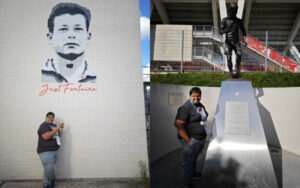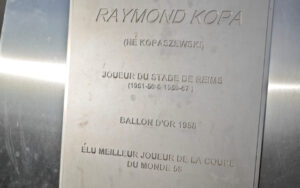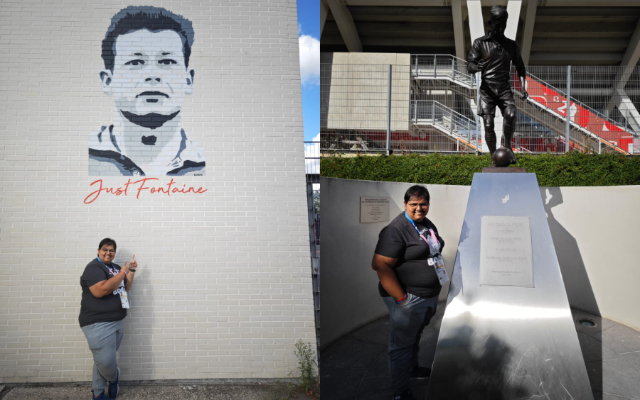
Trisha Ghosal in Reims
Visiting the Stade de Reims, even with its gates firmly shut, is like stepping into the pages of a grand, forgotten epic. The stadium might be silent, its stands empty, but the air thrums with the stories of the past—tales of triumph, artistry, and the indomitable human spirit. As I stood outside the arena, a chill ran down my spine, not from the cool breeze, but from the overwhelming presence of history, embodied in two iconic figures: Raymond Kopa and Just Fontaine.
At the entrance, a bronze statue commands attention — Kopa, frozen in time, captured in the midst of a graceful stride. There’s a life to this statue, an energy that makes it seem as if Kopa might spring to life at any moment, ready to weave through defenders with the effortless elegance that made him a legend. The bronze reflects the light, almost glowing, as if reminding us that Kopa’s brilliance will never truly fade. His roots may have been in Poland, but it was here in France that he blossomed, becoming the first great star of French football—a beacon for those who would follow, like Michel Platini and Zinedine Zidane.
Kopa’s story is one of those rare ones that transcends sport, touching something deeper within us. Born to Polish immigrants in the harsh coal-mining towns of northern France, young Raymond Kopaszewski could have easily been destined for a life of hard labour. But fate had other plans. His feet, it seemed, were born to dance on the pitch, not to trudge through the coal mines.
For the Latest Sports News: Click Here

At Stade de Reims, Kopa’s artistry turned the football field into a canvas. He didn’t just play the game; he reimagined it, becoming the linchpin of a team that reached the first European Cup final in 1956. Although Reims narrowly lost to Real Madrid, Kopa’s performance was unforgettable. That summer, he was drawn to Madrid like a comet to the sun, joining forces with Alfredo Di Stefano and, later, Ferenc Puskas.
In Madrid, Kopa shone even brighter. He won three European Cups with Real Madrid, a feat that stamped his name into the annals of football history. But perhaps his most extraordinary achievement came in the 1958 World Cup in Sweden. It was a tournament of dreams, where France finished third, and where Kopa’s creativity allowed Just Fontaine to etch his own name into the history books with 13 goals—a record that still stands today. Fontaine was the sword, but Kopa was the hand that guided it. Their partnership on the pitch was nothing short of poetry.
As I turned from Kopa’s statue, my eyes caught sight of a mural on the stadium wall—a tribute to Fontaine, the Morocco-born forward who scored that baker’s dozen of goals with a relentless hunger that could only be fuelled by genius. Fontaine’s face, etched in the mural, carries a look of fierce determination, his eyes burning with the same fire that propelled him to football immortality. The mural is a testament to a moment in time when two men, together, brought the world to its knees with their brilliance.

Standing there, I wasn’t just a visitor; I was a pilgrim, paying homage at the shrine of football’s sacred past. Kopa and Fontaine were more than just players—they were pioneers, artists, dreamers who turned the ordinary into the extraordinary. Their legacies are not just carved in stone or bronze, but in the hearts of all who love the beautiful game, and even those who don’t. Because their story is not just about football; it’s about what it means to be human. It’s about rising from humble beginnings, overcoming the odds, and leaving a mark on the world that time cannot erase.
In Kopa’s statue and Fontaine’s mural, I saw not just two great athletes, but the embodiment of possibility. They remind us that greatness is not confined to one field, one era, or one life. It’s a flame that can be passed on, lighting the way for others to follow. Leaving the Stade de Reims, I carried with me more than just memories of two football legends—I carried a renewed belief in the power of dreams, in the beauty of creation, and in the enduring magic of human potential.
Even if football is not your passion, their story is universal—a reminder that every once in a while, the world gifts us with people who redefine what is possible, not just in sports, but in life itself.
Also Read: Paris Paralympics have the power to change perceptions back home




